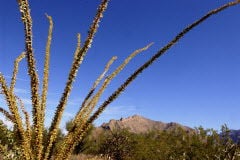Saguaros may need watering; cherry tree woes; excess soil salt
Answers to your gardening questions from an expert in Southern Arizona.
- By Peter L. Warren Special to the Arizona Daily Star
- Updated
Q: I planted three Flowering Yoshino Cherry trees from pots about four years ago. Watered and fertilized the same for all these years. Two of the trees are doing okay. For some reason, one of the cherry trees started to drops its leaves. There is some kind of white sap coming out from the lower part of this one tree.
I do not know if the sap has anything to do with the tree dying. Do you know what might be causing the tree to look wilted and leaves to drop? This started before the high temperatures we have been getting.
A: Cherry trees and related fruit trees may ooze sap and drop leaves in response to injury. The injury can be due to freeze damage, insect feeding, disease, wounding from tools, hail, or sun scald of the bark. If you see any sawdust around the wound or in the sap, insects become a prime suspect.
The location of the wounds may be significant since some insects usually attack the lower trunk, others the upper branches. If you only see the cracking on the sunniest sides of the tree, the scalding is more likely.
From your photo, there doesn’t seem to be any obvious injuries from tools. If you experienced any freezing last winter or hail damage, they are possibly to blame. Please let me know if you come up with any more clues to help solve this puzzle.
Peter L. Warren is the urban horticulture agent for the Pima County Cooperative Extension and the University of Arizona. Questions may be emailed to
- By Peter L. Warren Special to the Arizona Daily Star
- Updated
Q: I have a palm tree where the frond tips are turning yellow. I know that the lower fronds usually turn yellow or brown due to age, but the yellowing tips are throughout the entire tree. I have not changed any watering or fertilizing schedules. Any thoughts on why this yellowing is occurring?
A: Frond tips turning yellow and brown are often a symptom of drought and excess salt in the soil around the roots. Fortunately, the cure for both of these is the same, more water.
A good soak once every few months will help wash the salt out of the root zone. The rest of the time these trees should be getting water every seven to 10 days in the summer, 10 to 14 days in the spring and fall, and every two to three weeks in the winter. Each time the water should reach a depth of 36 inches. With proper irrigation and an occasional soak, you will soon see how we can be good fronds for the palms.
Peter L. Warren is the urban horticulture agent for the Pima County Cooperative Extension and the University of Arizona. Questions may be emailed to
- By Peter L. Warren Special to the Arizona Daily Star
- Updated
Q: We have three saguaros in our front yard, two, four and 10 feet tall. All appear to be healthy. The tallest one will get only two or three blooms each year. Before they can open they all dry up and fall off. Do you know what would cause this? Other saguaros in the area will have buds that open up into flowers. The 10-foot saguaro was transplanted into our yard about six years ago.
A: Dropping flower buds are sometimes associated with environmental stress, so first I’m curious to know if they are receiving enough irrigation. Some saguaros planted in our landscapes don’t end up in ideal locations so we might need to take better care of them than those in the wild desert.
Typically, they don’t need much water but they do need some. The recommendation is once every two weeks in the summer, every three to four weeks in the spring and fall, and none in the winter. Of course, you can skip the months where we get significant rain during the monsoon season. If you can rule out the water problem, consider what other factors in your environment could be affecting the area where they are growing.
Peter L. Warren is the urban horticulture agent for the Pima County Cooperative Extension and the University of Arizona. Questions may be emailed to
- By Peter L. Warren Special to the Arizona Daily Star
- Updated
Q: The attached photo, kindly sent to me by a friend who checks my house while we are away for the summer, shows my euphorbia houseplant with drooping stalks. I have been researching online, to no avail. As of a week ago, he said the plant still appeared green in color.
A: Euphorbias should be treated much like cactus. They need well-drained soil and can suffer from fungal diseases if left in too much water for too long. Your plant is showing signs of a vascular problem in that it cannot provide enough water pressure to keep some of the stems upright. Wilting like this can be a sign of underwatering but it can also be a sign of overwatering or disease when the stems are clogged with fungi.
If you can rule out under watering, then consider your container. From your photo, it appears the container doesn’t have a way to drain and if that’s true, it can be part of the problem. You might try cutting off a wilted stem and look at the cross section to see if it appears to be diseased. It would likely be discolored if it were diseased.
If so, it’s possible you can cut off the infested parts and still have a surviving plant. Be sure to disinfect your pruners between cutting diseased tissue and healthy parts in case it can be spread on your tools. You can use a diluted bleach solution or rubbing alcohol solution (one part to nine parts water).
Once you cut off the diseased parts, the first thing to do is see if your plant container can be replaced with one that drains so any excess water can be diverted from the root zone. If a disease has spread to the main stem, there might not be anything to do for your plant. Time will tell.
Peter L. Warren is the urban horticulture agent for the Pima County Cooperative Extension and the University of Arizona. Questions may be emailed to
- By Peter L. Warren Special to the Arizona Daily Star
- Updated
Q: The leaves/stalks in the center of my desert spoon plants are being eaten away about 6 inches up from the base. I don’t see any problem from the base and only water them about once per month with a hose. What is causing the problem and what can I do to make them healthy again?
A: It appears your desert spoons are a food source for a four-legged critter, probably javelina. These animals will feed on a variety of cacti and succulents. The solution is fencing or some sort of a detour around the plants you are trying to protect. Keep up the good care you are already providing and see if you can devise some fencing system that suits your landscape plan.
Peter L. Warren is the urban horticulture agent for the Pima County Cooperative Extension and the University of Arizona. Questions may be emailed to
- By Peter L. Warren Special to the Arizona Daily Star
- Updated
Q: I have six bougainvillea plants in my back yard. I have three on the east side and three on the west side planted about a year ago. Last summer the ones on the west side looked great and ones on the east side looked really bad. This summer the ones on the east side look great (see picture), the ones on the west side (not shown) look really bad.
We feed them and spray for bugs but still no luck. The water system goes off every other day at 7 a.m. and 3 p.m. My wife also waters them with the hose. But we can’t seem the get them to look good at the same time. Do you have any ideas as to what we can do?
A: Bougainvilleas are fairly tough plants once established and by the time they are a year old they should be doing well. The trouble last summer could have been from the shock of transplanting them. The plants on the east side appear to be getting western afternoon sun. That is where they do best and your plants on that side look great.
The plants on the west side appear to be getting eastern morning sun and might be shaded in the afternoon by the wall. Since full sun is prescribed for these plants, it could be a factor for the ones that may be shaded. It’s hard for me to say from the photos (not shown) how much shade they get but it’s something to keep in mind.
From your description, the trouble this year may be due to overfertilizing and overwatering. Once or twice each year is all you need to fertilize and watering should be done less often and deeper than your current schedule. Try switching your irrigation schedule to once every seven to 10 days to a depth of 12 to 18 inches in the summer. Then you can reduce the irrigation to once every two weeks in the fall and every three weeks in the winter.
Peter L. Warren is the urban horticulture agent for the Pima County Cooperative Extension and the University of Arizona. Questions may be emailed to
- By Peter L. Warren Special to the Arizona Daily Star
- Updated
Q: We have infested-with-mealybugs prickly pears on a border with a neighbor who insists that the only way to control the infestation is to use a Bayer Tree and Shrub chemical. I so dislike and try to avoid these solutions. Can you direct me to an online intelligent discussion that isn’t sponsored by Bayer? Or do you have a nonpoisonous alternative?
A: I suspect what you are seeing isn’t mealybugs but rather Cochineal scale (Dactylopious coccus) on your prickly pear cactus. The easiest treatment is spraying them with a hose. You can also use a soap solution (1 tablespoon per gallon of water).
While the Bayer product will kill these insects, it is also likely to kill beneficial insects in the area that may be feeding on the scale insects. You and your neighbor shouldn’t expect to eradicate these insects. They are very common in our area and will likely continue to feed on the cactus no matter what method you choose.
Fortunately, they aren’t likely to kill these plants if you spray them with a hose periodically.
Peter L. Warren is the urban horticulture agent for the Pima County Cooperative Extension and the University of Arizona. Questions may be emailed to
- By Peter L. Warren Special to the Arizona Daily Star
- Updated
Q: What are these bugs on this milkweed?
A: The red and black ones are milkweed bugs. That might seem like a snarky answer but it’s the official common name for these insects otherwise known as Oncopeltus fasciatus. They can also be found on oleander plants, which might explain why the yellow insects are called oleander aphids (Aphis nerii).
Both species are commonly found on milkweed and oleander plants. Insects tend to favor specific plants or plant families when they feed. Milkweed and oleander are relatives from the same plant family and known for their sap that contains cardiac glycosides, which are poisonous. The insects that ingest it as a food source are able to sequester it and become protected to some extent.
If you watch other animals preying on these insects, you may notice they spit them back out. The red and yellow coloration is nature’s way of warning predators to leave them alone but not everyone understands the warning signs without a taste test.
Peter L. Warren is the urban horticulture agent for the Pima County Cooperative Extension and the University of Arizona. Questions may be emailed to
- By Peter L. Warren Special to the Arizona Daily Star
- Updated
Q: When your time permits, Would you share your thoughts on this newest visitor to the garden? He/she has increased in numbers over the past weeks and I have yet to determine which plant is part of their meal choices.
A: The insect, Pyropyga nigricans, is a firefly species without a light. These are predatory insects and are garden helpers so you’re lucky to have them.
Peter L. Warren is the urban horticulture agent for the Pima County Cooperative Extension and the University of Arizona. Questions may be emailed to
- By Peter L. Warren Special to the Arizona Daily Star
- Updated
Q: I have a lilac bush, which I purchased from a mail order company. It is about 12 years old, and it has never bloomed a single flower. It grows larger each year and has lush green foliage. I have given it fertilizer but nothing seems to help. What am I doing wrong?
A: The common lilac (Syringa vulgaris) is a favorite in many places so I understand your desire to grow them. Unfortunately, your place might not be suitable. Lack of blooms is usually related to one of six causes: the age of the plant, temperature, alternate flowering, light, nutrition, or pruning practices. In your situation, I think the likely problem is temperature. Lilacs require a certain amount of cold to trigger blooming, also known as vernalization. We don’t usually get enough cold in Southern Arizona for this plant to bloom unless you live at higher elevations. There are lilacs at the Santa Rita Experimental Range near Green Valley than have been monitored for bloom times by the USA National Phenology Network for many years. The elevation there is approximately 3,714 feet above sea level. You can check their web site for details if you are interested: usanpn.org/nn/lilacs
In downtown Tucson, where the elevation is closer to 2,389 and winter is barely recognizable, it’s too warm.
Peter L. Warren is the urban horticulture agent for the Pima County Cooperative Extension and the University of Arizona. Questions may be emailed to
- By Peter L. Warren Special to the Arizona Daily Star
- Updated
Q: My husband pruned two of our Mexican bird of paradise shrubs way down. Only one came back and is doing nicely. We have watered and used Miracle Grow fertilizer on the other one but nothing happens. Will it come back next season or do we need to replant a new one?
A: If you aren’t seeing any new growth by now, I suspect it’s a goner. You can scratch the surface of the branches to see if there is any green beneath. The good news is you can probably plant new ones from the seeds of the one that is doing nicely. The Mexican bird of paradise (Caesalpinia mexicana) is one of three species that grow in our area. The other two are the yellow (Caesalpinia gilliesii) and red (Caesalpinia pulcherrima) birds of paradise. A good time to prune is once blooming is finished. If you cut them too short, you risk killing them. Try just cutting back the top third next time to be safe. The flower stalks on all three species may be removed to prevent seedpods from forming and to reduce the likelihood of volunteer seedlings. If the pods are left on the plant to dry and split, the seeds can be thrown a surprising distance. The red bird of paradise dies back to ground at temperatures below freezing. It generally regrows in spring, from the ground and the dead parts can be pruned to a few inches above the ground in late winter. Mulching the base of plant in colder areas may protect the plant’s crown until spring.
Peter L. Warren is the urban horticulture agent for the Pima County Cooperative Extension and the University of Arizona. Questions may be emailed to
- By Peter L. Warren Special to the Arizona Daily Star
- Updated
Q: I plan to buy a 15-gallon fruitless olive tree. Please tell me how much water daily or weekly it should be given once planted. The irrigation system in place for shrubs and trees comes on Monday and Friday for one hour. There are two black adjustable 10-gallon emitters where the tree will be planted. If the tree requires daily watering instead of the two days, I can water with a hose. When the temperature increases to 90 and higher, the irrigation system waters Monday, Wednesday, and Friday for two hours.
A: Olive trees should receive water every seven to 10 days in the summer to a depth of 24 to 36 inches. In the spring and fall, you can water every 10 to 14 days and in the winter, you can water every 14 to 21 days. Typically, two emitters can supply new trees as you described. As trees get older and their root zones increase in size, adding an emitter to the increasingly wider circle of drip irrigation would be appropriate every few years. The depth of irrigation can be measured with a soil probe. The schedule you are using now is watering too often and will encourage shallow root growth that will be more susceptible to our blast furnace summer heat.
Peter L. Warren is the urban horticulture agent for the Pima County Cooperative Extension and the University of Arizona. Questions may be emailed to
- By Peter L. Warren Special to the Arizona Daily Star
- Updated
Q: These caterpillar bugs are all over my Texas mountain laurel (the same one that had the red and black plant bugs in March – which I sprayed off with a soap solution). There are probably at least 10 groups of these caterpillars on the tree. Suggestions?
A: These insects are called genista caterpillars (Uresiphita reversalis) and they are commonly found throughout the southwest on Texas mountain laurels. Their damage doesn’t affect the overall health of the tree unless there are unusually high numbers of them. The damage is often only cosmetic. The same soap solution can be used against these caterpillars. Soap acts an irritant and doesn’t always completely solve the problem. You might get the same result by spraying them with a hose. The benefit of the caterpillars is they are food for birds so you could leave them there and put up with the minor damage the caterpillars cause when feeding. Other solutions include pruning off the infested ends of branches, hand-picking the caterpillars, and various insecticides labeled for use on landscape trees and shrubs. An organic solution is spraying Bt (Bacillus thuringiensis) on the leaves where they are feeding. This works best when the caterpillars are young and most susceptible to the poison. The Bt bacteria are poisonous to caterpillars but not to anything else. Since there are several strains of Bt, make sure you use the one labeled for caterpillar pests. As always, when using any pesticide it is important to read the label and follow instructions to protect you and those other non-target organisms that might be exposed to the spray. By the way, the red and black bugs (Lopidea major) you saw earlier this year are also just a minor pest that feeds on Texas mountain laurel.
Peter L. Warren is the urban horticulture agent for the Pima County Cooperative Extension and the University of Arizona. Questions may be emailed totucsongardensage@gmail.com
- By Peter L. Warren Special to the Arizona Daily Star
- Updated
Q: I have a question about compost. My neighbors have two eucalyptus trees, which shed many leaves into my yard. Are these good to put into the compost or not? I have concerns because of oil they may have in the leaves.
A: Eucalyptus leaves are fine for compost. They need to be broken down like any plant matter put into compost so that any compounds that are otherwise harmful will be neutralized. The oil that you refer to has been reported to interfere with germination in some plants but that is not something to be concerned about with composted material.
Peter L. Warren is the urban horticulture agent for the Pima County Cooperative Extension and the University of Arizona. Questions may be emailed to tucsongardensage@gmail.com
- By Peter L. Warren Special to the Arizona Daily Star
- Updated
Q: This may be an odd question but here goes: I have an apricot tree in my yard (at least 15 years old) and it was a dwarf/ semi-dwarf when I planted it. I chose one that required the lowest chilling hours. I cannot remember the type or the name. It is still a reliable producer, self-pollinating and ripens in May. Do you have any guesses what the name of it could be? I think I remember the name included the word Gold.
A: I suspect your apricot variety is Gold Kist. This is an excellent backyard apricot for warm winter climates. Its features include very good quality, freestone fruit, and it is heavy bearing. It is an early harvest variety, from late May to early June. It requires 300 chill hours and is self-fruitful.
- By Peter L. Warren Special to the Arizona Daily Star
- Updated
Q: I have a question related to the “Desert Museum” palo verde.
I want to plant this tree at our house, but I am a little wary because of the threat of palo verde beetles getting to the roots and killing it prematurely. Perhaps you can help me assess this risk?
A: The main risk for these beetles is an unhealthy tree. The palo verde beetle is endemic to this area and there is little to be done to a tree that has been infested. They are known to attack stressed trees so the best prevention is to keep trees as healthy as possible. This is primarily accomplished by providing proper irrigation and pruning. Since these are native desert trees they can survive on rainwater but when we have drier conditions than usual, supplemental water can help. Typically for desert trees this means installing drip irrigation around the tree at the drip line and providing deep watering to a depth of 24 to 36 inches every 14 to 21 days in the spring, summer, and fall. In the winter you can skip the irrigation, assuming we have normal winter rains. Proper pruning when the tree is young will result in a mature tree that is structurally stronger, lives longer, and is less costly to maintain. Don’t be in a hurry to prune at planting. A newly planted young tree should be given a chance to put down roots before taking any branches off unless they were damaged in the planting process. After a year or so it will be time to structurally prune your tree to ensure its long-term health.
Peter L. Warren is the urban horticulture agent for the Pima County Cooperative Extension and the University of Arizona. Questions may be emailed to tucsongardensage@gmail.com
- By Peter L. Warren Special to the Arizona Daily Star
- Updated
Q: This year, we have some peaches with dimples. The fruit is rotten inside. Could it be a plant pathogen of some kind?
A: The short answer is yes. Your peaches are likely suffering from a pathogen as a result of insect feeding damage. The prime suspect in this case is the leaf-footed bug. These insects have piercing-sucking mouthparts and while feeding on young developing fruit leave scars that are known as cat-facing and sometimes this feeding activity will introduce fungi that may cause the rot.
Leaf-footed bugs are common in our area and may feed on a variety of plants including pomegranate, pecan, citrus, and peaches. They are difficult to manage once in the adult stage because they can fly and move about quickly.
There are insecticides available, but they are only effective on the young bugs. These insecticides are harmful to bees, so take care to avoid spraying plants in bloom. Monitoring for and removing egg masses in the early spring is another tactic that is potentially more successful if you are persistently looking in the spring when eggs are laid and young bugs are emerging from them.
Peter L. Warren is the urban horticulture agent for the Pima County Cooperative Extension and the University of Arizona. Questions may be emailed to tucsongardensage@gmail.com
- By Peter L. Warren Special to the Arizona Daily Star
- Updated
Q: What is going on with my rosemary bush? Two days ago I looked at the bush and discovered damage.
A: Rosemary (Rosmarinus officinalis) is a shrub that grows well in the desert. The natural form is shaggier than the sheared version you have growing. The damage you are seeing is likely a result of regular shearing of the foliage. Often shearing creates a shell of green that prevents light from entering the inner parts of the plant. Eventually dead spots will occur and regrowth from those branches will not likely happen. A better treatment would be less frequent light pruning as necessary and in a more selective fashion to allow the plant to achieve its natural form and to open up the plant a bit to light, air, and water.
Peter L. Warren is the urban horticulture agent for the Pima County Cooperative Extension and the University of Arizona. Questions may be emailed to tucsongardensage@gmail.com
- By Peter L. Warren Special to the Arizona Daily Star
- Updated
Q: We have 30-year-old Rhaphiolepis indica planted in a slightly raised planter. One side was particularly hit hard by the freeze a few years ago (17 degrees in Tucson in February), or so we thought, until we caught a couple of deer munching on that particular shrub. It never recovered from the munching. The shrubs on the other side of the planter were doing well until four deer became emboldened and began munching on the flowers and new leaf growth on the other side near our front gate. Those plants, too, have stopped putting on new leaves and weeks later look exactly like the deer left them. What can we do to rejuvenate the plants/encourage them to grow again?
A: Deer munching is definitely a hazard for Rhaphiolepis indica (Indian hawthorn), so some sort of fencing or detours around your shrub are required before you spend a lot of time on rejuvenation.
The best time to prune is around May or when it is finished blooming. You can selectively prune out the damaged branches where deer were feeding. From your photo the shrub looks pretty full and selective pruning should help open it up to more light, air, and water as well. Otherwise, continue to provide sufficient water, fertilize annually and monitor deer activity as needed.
Peter L. Warren is the urban horticulture agent for the Pima County Cooperative Extension and the University of Arizona. Questions may be emailed to tucsongardensage@gmail.com
- By Peter L. Warren Special to the Arizona Daily Star
- Updated
Q: I am sending two photos of my desert willow tree, now in its fourth spring. The buds form, grow and then dry out before opening. Have taken samples to Mesquite Valley Growers. They see no evidence of pests or disease, and recommended more water and fertilizer. The leaves seem smaller and shorter than others I see.
A: I agree with Mesquite Valley Growers; the symptoms you describe are likely related to insufficient watering. The recommended schedule for desert trees is once every two to three weeks in the spring, summer, and fall to a depth of 24 to 36 inches. An annual spring fertilizer application wouldn’t hurt either, making sure the fertilizer is watered in to reach the absorbing roots.
Peter L. Warren is the urban horticulture agent for the Pima County Cooperative Extension and the University of Arizona. Questions may be emailed to tucsongardensage@gmail.com
- By Peter L. Warren Special to the Arizona Daily Star
- Updated
Q: I purchased this sugar bush at Desert Survivors Native Plant Nursery two years ago. It chronically looks like it isn’t getting enough water; there are dry, brown leaves. It is planted in desert soil with a cactus mix amendment. It is on a shrub line that runs twice a week right now, for 2½ hours. I have played with the emitter flow and am putting about 20 gallons each application. It gets sun until about 3 p.m. Is there anything I can do to help it thrive?
A: Sugar bush (Rhus ovata) is a moderate water user but twice per week at 20 gallons each application seems like a lot of water for a native shrub. If you aren’t checking to see how deep the water is going, I suggest using a soil probe to determine the depth of the watering. Ideally, water should reach a depth of 24 to 36 inches. I recommend backing off your irrigation to once a week for the summer and once every two weeks in the spring and fall.
Overwatering sometimes shows similar symptoms to underwatering, so looks can be deceiving.
Peter L. Warren is the urban horticulture agent for the Pima County Cooperative Extension and the University of Arizona. Questions may be emailed to tucsongardensage@gmail.com
- By Peter L. Warren Special to the Arizona Daily Star
- Updated
Q: I have a customer who is trying to identify a plant. She says it can change directions of the branching/leaves almost at will. It has leaves like a wild chive or a hesperaloe combination.
A: It is from the genus Kniphofia, and commonly called tritoma, red-hot poker, torch lily, knofflers, or poker plant. They are closely related to aloes, although Kniphofias don’t have very succulent leaves. There are quite a few species and cultivars of different colors. It is native to Africa. The plant has a mature height of 2 to 4 feet and a width of 3 feet. It does well in a site with full sun and well-drained soil.
Peter L. Warren is the urban horticulture agent for the Pima County Cooperative Extension and the University of Arizona. Questions may be emailed to tucsongardensage@gmail.com
- By Peter L. Warren Special to the Arizona Daily Star
- Updated
Q: My orange tree has been very productive for 14 years but it put out small fruit last year and this year it is blooming more than a month later than usual. Is something wrong with my tree?
A: Both symptoms you described, small fruit and odd bloom time, are associated with lack of water. It is possible that your irrigation system needs adjusting, so that would be the first thing to check. Also we had a relatively dry late winter and early spring this year. If you reduced your irrigation for the winter as recommended and then experienced no rain in February and March, your tree was probably in need of more water. Citrus trees sometimes respond to drought conditions followed by rain with a bloom about a month later, which corresponds to the rain you had in early April.
Peter L. Warren is the urban horticulture agent for the Pima County Cooperative Extension and the University of Arizona. Questions may be emailed to tucsongardensage@gmail.com
- By Peter L. Warren Special to the Arizona Daily Star
- Updated
Q: How likely are seriously neglected mature citrus trees to recover?
Our trees are located in central Tucson and have curling leaves, and we will not be able to water them until after May 20. They probably have not been watered (other than rain of course) since last summer.
A: It’s hard to say for sure without seeing them. Curling leaves is a symptom of drought so watering soon would be good. That said, at least the leaves are still on the tree and that should give you hope. The next thing the trees will do without water is drop the leaves to reduce the amount of water escaping into the atmosphere through the leaves. Make sure that when you have the opportunity to water that you put the trees on drip irrigation arranged in a circular fashion around the drip line of the trees. The timing should be set for once every seven to 10 days now that we are experiencing the hottest and driest part of the year. Also make sure the water gets to a depth of 36 inches in the soil. You can measure this with a simple soil probe.
Peter L. Warren is the urban horticulture agent for the Pima County Cooperative Extension and the University of Arizona. Questions may be emailed to tucsongardensage@gmail.com
- By Peter L. Warren Special to the Arizona Daily Star
- Updated
Q: Why are bees in my vegetable garden? They appear to be digging in the soil. Makes it impossible to get veggies.
A: Many species of solitary bees make their homes in the soil. A group called digger bees or Anthophora (meaning “flower bearer”) are extremely common and they sometimes nest in large numbers like a community of single-family homes. Your garden is likely a good spot, according to the bees. They are not typically aggressive should you want to work around them. If you want to discourage them from nesting there, one thing you can try is using an overhead sprinkler in the area where they are nesting. Digger bees will often seek a new habitat if there is regular water raining down on their holes. Since these are also some of our native pollinators, it is good to keep them alive and nearby, if not in your garden.
Peter L. Warren is the urban horticulture agent for the Pima County Cooperative Extension and the University of Arizona. Questions may be emailed to tucsongardensage@gmail.com
- By Peter L. Warren Special to the Arizona Daily Star
- Updated
Q: We live at 4,000 feet of elevation at the base of the Santa Ritas and have two “rescued” saguaros and one nursery bought.
The biggest is George (pictured). We moved George here in 2010 from a construction excavation site. We have licenses for all three of them. He did great first year then 2011, the winter from hell, arrived. A great deal of his south side froze in the wet, windy, and below-freezing temps we had for four days. He survived the damage and thrived. The side in this picture is facing north toward the Catalinas. Over the past few years, he has become a high rise apartment complex for Gila woodpeckers. This year three additional holes appeared as prior holes are now occupied by European starlings. Now he has six large holes. A month ago this splotchy patch (pictured) appeared on the north side, underneath a rather large hole taken over by the starling family. Is this some kind of fungus or could the tissue be damaged from internal carving of the hole inside and nearby? Never had the starlings before and given George’s height, no way to get rid of them. At least the Gilas return to the same homes every year but this year had to drill more!
A: The splotchy patch appears to be a symptom of bacterial necrosis caused by the bacterium Erwinia cacticida. The initial symptom is typically a small, light-colored spot with a water-soaked margin on the surface of the trunk or branches. Obviously, you are looking out for George because symptoms like that could easily go unnoticed. The tissue under the infection site appears to be showing a brown color and may eventually turn almost black. As the disease progresses, the tissue may crack and exude a dark brown liquid. If decay is slow, the tissue may not show the liquid. Although it’s tempting to blame the invasive European starlings, the bacteria could be transmitted by any number of animals, not to mention wind blowing it in from nearby plants.
If the damage was very small and reachable, I might suggest carving it out. Given the height of George and the spread of the symptoms, it might be best to either call an arborist with the proper equipment to reach that high or just let nature take its course. I can’t tell if there is any danger to people or property from the photo but it would be wise to consider the potential hazard if the problem gets a lot worse.
Peter L. Warren is the urban horticulture agent for the Pima County Cooperative Extension and the University of Arizona. Questions may be emailed to tucsongardensage@gmail.com
- By Peter L. Warren Special to the Arizona Daily Star
- Updated
- By Peter L. Warren Special to the Arizona Daily Star
- Updated
- By Peter L. Warren Special to the Arizona Daily Star
- Updated
Q: I have a royal robe potato bush that when planted last year grew beautifully! I live in Hayden so the plant is in the full sun all day.
This year, however, it is not doing well at all. I believe the reason is that it was hit hard during the winter freeze. I trimmed the branches back to about 10 inches from the roots. Even though the branches are very dry and snap off easily there are actually some green leaves growing on a few of the branches. Should I just dig it up and start over, or wait awhile to see if it comes back to the original beauty I had from the beginning?
A: The royal robe potato bush (Lycianthes rantonnetii or Solanum rantonnetii) is a tropical plant that originated in South America. It grows well in our heat with adequate water but needs a little protection in the winter if temperatures get below freezing. Because potato bushes flower on new wood, prune them in winter before they start to put out new growth. You can prune them as early as they have finished blooming for the year. The golden rule of pruning is never take off more than a third at one time to avoid stressing out the plant. Since yours has new growth showing, you could see how it grows before giving up and starting over.
Peter L. Warren is the urban horticulture agent for the Pima County Cooperative Extension and the University of Arizona. Questions may be emailed to tucsongardensage@gmail.com
- By Peter L. Warren Special to the Arizona Daily Star
- Updated
Q: We just installed five viga posts on our back patio. Two of them are where I could plant a vine in the ground; the other three need to be in a pot. Height to the patio roof is about 11 feet. Looking for something I can train to grow up and around the post, but the kind that cling. The area gets morning sun until about 11:30 a.m. and then shade the rest of the day. Flowering, thornless and non-deciduous would be ideal. Would also like to find a vine that I might be able to use along our retaining wall, specifically in the sections that have an iron railing between the stucco posts. This would be full sun most of the day and the height of the iron fence is about 6 feet.
Answer: My first thought is star jasmine because I have it growing at my house and it’s flowering now. It does well in part shade and produces very fragrant flowers in the spring. For the retaining wall, you might consider cat’s claw. This vine loves full sun and will cover a sturdy wall. These are fast growing and need to be managed but most vines are that way to some extent. There are other vines to choose from; search for options at az1606.pdf
Peter L. Warren is the urban horticulture agent for the Pima County Cooperative Extension and the University of Arizona. Questions may be emailed to
- By Peter L. Warren Special to the Arizona Daily Star
- Updated
Q: Thanks for the bug lesson last weekend at the Jewish Community Center. Thanks to you, I was able to identify lace bugs on our sunflowers (you predicted they would show up) and I mitigated with blue Dawn. While there, I noticed that our Japanese eggplant have something going on with them. Are you able to help out based on the two images I am including? No insects were visible.
A: Flea beetles are eating your eggplant leaves. They are tiny and hard to see, and they tend to jump like fleas when they sense danger. They are one of the most difficult-to-manage pests of eggplant and cole crops. They are also a problem on seedlings of tomatoes, potatoes, peppers, turnips, radishes and corn. There are various species of flea beetles, all members of the Chrysomelidae family. The adults are active leaf-feeders that can, in large numbers, rapidly defoliate and kill plants. You are seeing the symptoms of adult flea beetle feeding: small, rounded, irregular holes that make leaves look as if they had been peppered with fine shot. Additional damage may be done by the larvae, which feed on plant roots. Some flea beetles are considered general feeders, though many species attack only one plant or closely related kinds of plants. Because of this you can sometimes use anther crop to lure them away. For example, radishes are sometimes preferred over eggplant. Another tactic is to put yellow sticky traps near your plants to attract and capture these insects. Organic products that have some effectiveness are insecticidal soap and neem oil. Pyrethrin products such as Pyganic as well as hot pepper wax and rotenone are reported to be better.
No matter what you choose, the most important things to do are spray them early in the season before they do too much damage to young plants and read the label before you use these products so you are aware of safety precautions for using them.
Peter L. Warren is the urban horticulture agent for the Pima County Cooperative Extension and the University of Arizona. Questions may be emailed to
- By Peter L. Warren Special to the Arizona Daily Star
- Updated
Q: I live in Barrio Santa Rosa and have two massive Aleppos that were planted on my property in the early 1950s. I have noticed recently that many of the lower branches on one of the trees are dying. I am seeing brown needles throughout the tree, but not a lot. These trees have defined our property and it looks like they may have fallen victim to the bark beetle. One of the trees looks fine; the other I can see a dozen of the lowest limbs dead. This one has brown leaves sporadically throughout, but mostly at the bottom, not at the crown.
I have had the entire property on drip for 15 years or more, so I always considered them adequately watered. Also, the gutters from the roof drain into this part of the yard. Any advice you can give me would be greatly appreciated. What I’d really like to hear you say is that they just need a bit more water!
A: Your trees don’t appear to be infested with bark beetles from the photos. The holes look like woodpecker damage and the dead branches in the crown of the tree are normal as the trees age. It would be good to hire an arborist to climb the trees and cut out the dead and damaged branches both to clean it up and also to prevent dead limbs from falling and hurting you or damaging your property. Watering these large trees is difficult because the root zones extend two to three times the height of the tree. You are likely not getting water to the absorbing roots at the end by using a hose. The best you can do is drip irrigation with emitters arranged in a circular fashion outside the drip line of the tree. The schedule for watering should be every seven to 14 days in the summer, every 10 to 21 days in the spring and summer, and every 14 to 21 days in the winter. The water should reach a depth of 24 to 36 inches each time and you can use a soil probe to determine how deep the water is going. So it’s not time to give up
Peter L. Warren is the urban horticulture agent for the Pima County Cooperative Extension and the University of Arizona. Questions may be emailed to
- Updated
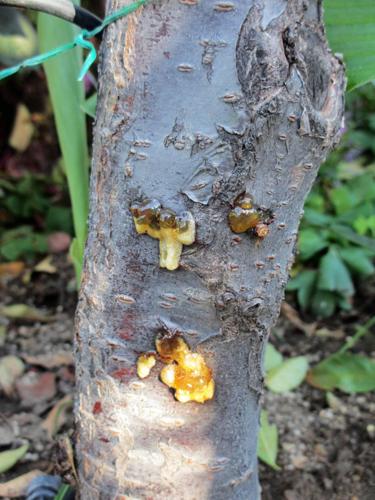
- By Peter L. Warren Special to the Arizona Daily Star
Q: I planted three Flowering Yoshino Cherry trees from pots about four years ago. Watered and fertilized the same for all these years. Two of the trees are doing okay. For some reason, one of the cherry trees started to drops its leaves. There is some kind of white sap coming out from the lower part of this one tree.
I do not know if the sap has anything to do with the tree dying. Do you know what might be causing the tree to look wilted and leaves to drop? This started before the high temperatures we have been getting.
A: Cherry trees and related fruit trees may ooze sap and drop leaves in response to injury. The injury can be due to freeze damage, insect feeding, disease, wounding from tools, hail, or sun scald of the bark. If you see any sawdust around the wound or in the sap, insects become a prime suspect.
The location of the wounds may be significant since some insects usually attack the lower trunk, others the upper branches. If you only see the cracking on the sunniest sides of the tree, the scalding is more likely.
From your photo, there doesn’t seem to be any obvious injuries from tools. If you experienced any freezing last winter or hail damage, they are possibly to blame. Please let me know if you come up with any more clues to help solve this puzzle.
Peter L. Warren is the urban horticulture agent for the Pima County Cooperative Extension and the University of Arizona. Questions may be emailed to
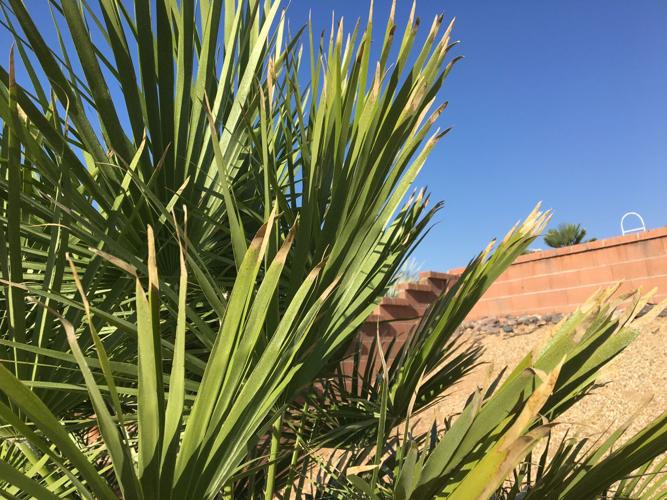
- By Peter L. Warren Special to the Arizona Daily Star
Q: I have a palm tree where the frond tips are turning yellow. I know that the lower fronds usually turn yellow or brown due to age, but the yellowing tips are throughout the entire tree. I have not changed any watering or fertilizing schedules. Any thoughts on why this yellowing is occurring?
A: Frond tips turning yellow and brown are often a symptom of drought and excess salt in the soil around the roots. Fortunately, the cure for both of these is the same, more water.
A good soak once every few months will help wash the salt out of the root zone. The rest of the time these trees should be getting water every seven to 10 days in the summer, 10 to 14 days in the spring and fall, and every two to three weeks in the winter. Each time the water should reach a depth of 36 inches. With proper irrigation and an occasional soak, you will soon see how we can be good fronds for the palms.
Peter L. Warren is the urban horticulture agent for the Pima County Cooperative Extension and the University of Arizona. Questions may be emailed to
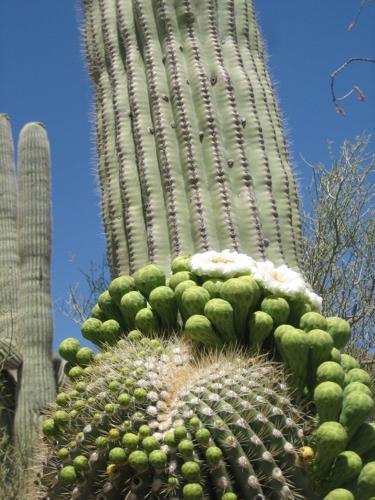
- By Peter L. Warren Special to the Arizona Daily Star
Q: We have three saguaros in our front yard, two, four and 10 feet tall. All appear to be healthy. The tallest one will get only two or three blooms each year. Before they can open they all dry up and fall off. Do you know what would cause this? Other saguaros in the area will have buds that open up into flowers. The 10-foot saguaro was transplanted into our yard about six years ago.
A: Dropping flower buds are sometimes associated with environmental stress, so first I’m curious to know if they are receiving enough irrigation. Some saguaros planted in our landscapes don’t end up in ideal locations so we might need to take better care of them than those in the wild desert.
Typically, they don’t need much water but they do need some. The recommendation is once every two weeks in the summer, every three to four weeks in the spring and fall, and none in the winter. Of course, you can skip the months where we get significant rain during the monsoon season. If you can rule out the water problem, consider what other factors in your environment could be affecting the area where they are growing.
Peter L. Warren is the urban horticulture agent for the Pima County Cooperative Extension and the University of Arizona. Questions may be emailed to

- By Peter L. Warren Special to the Arizona Daily Star
Q: The attached photo, kindly sent to me by a friend who checks my house while we are away for the summer, shows my euphorbia houseplant with drooping stalks. I have been researching online, to no avail. As of a week ago, he said the plant still appeared green in color.
A: Euphorbias should be treated much like cactus. They need well-drained soil and can suffer from fungal diseases if left in too much water for too long. Your plant is showing signs of a vascular problem in that it cannot provide enough water pressure to keep some of the stems upright. Wilting like this can be a sign of underwatering but it can also be a sign of overwatering or disease when the stems are clogged with fungi.
If you can rule out under watering, then consider your container. From your photo, it appears the container doesn’t have a way to drain and if that’s true, it can be part of the problem. You might try cutting off a wilted stem and look at the cross section to see if it appears to be diseased. It would likely be discolored if it were diseased.
If so, it’s possible you can cut off the infested parts and still have a surviving plant. Be sure to disinfect your pruners between cutting diseased tissue and healthy parts in case it can be spread on your tools. You can use a diluted bleach solution or rubbing alcohol solution (one part to nine parts water).
Once you cut off the diseased parts, the first thing to do is see if your plant container can be replaced with one that drains so any excess water can be diverted from the root zone. If a disease has spread to the main stem, there might not be anything to do for your plant. Time will tell.
Peter L. Warren is the urban horticulture agent for the Pima County Cooperative Extension and the University of Arizona. Questions may be emailed to
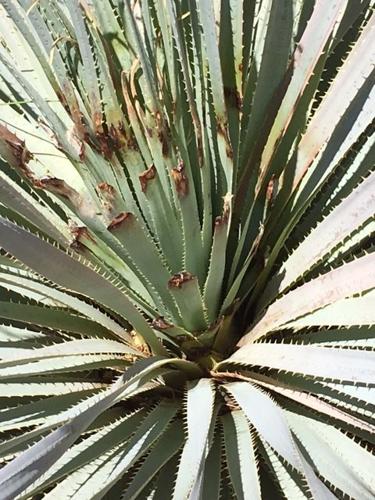
- By Peter L. Warren Special to the Arizona Daily Star
Q: The leaves/stalks in the center of my desert spoon plants are being eaten away about 6 inches up from the base. I don’t see any problem from the base and only water them about once per month with a hose. What is causing the problem and what can I do to make them healthy again?
A: It appears your desert spoons are a food source for a four-legged critter, probably javelina. These animals will feed on a variety of cacti and succulents. The solution is fencing or some sort of a detour around the plants you are trying to protect. Keep up the good care you are already providing and see if you can devise some fencing system that suits your landscape plan.
Peter L. Warren is the urban horticulture agent for the Pima County Cooperative Extension and the University of Arizona. Questions may be emailed to
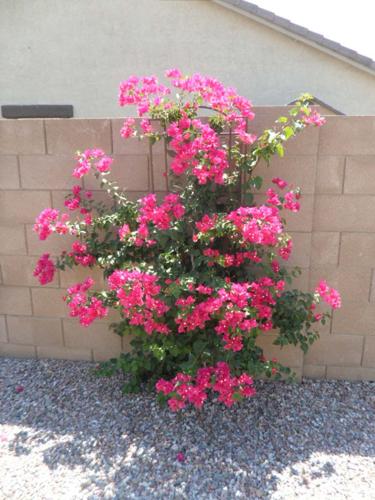
- By Peter L. Warren Special to the Arizona Daily Star
Q: I have six bougainvillea plants in my back yard. I have three on the east side and three on the west side planted about a year ago. Last summer the ones on the west side looked great and ones on the east side looked really bad. This summer the ones on the east side look great (see picture), the ones on the west side (not shown) look really bad.
We feed them and spray for bugs but still no luck. The water system goes off every other day at 7 a.m. and 3 p.m. My wife also waters them with the hose. But we can’t seem the get them to look good at the same time. Do you have any ideas as to what we can do?
A: Bougainvilleas are fairly tough plants once established and by the time they are a year old they should be doing well. The trouble last summer could have been from the shock of transplanting them. The plants on the east side appear to be getting western afternoon sun. That is where they do best and your plants on that side look great.
The plants on the west side appear to be getting eastern morning sun and might be shaded in the afternoon by the wall. Since full sun is prescribed for these plants, it could be a factor for the ones that may be shaded. It’s hard for me to say from the photos (not shown) how much shade they get but it’s something to keep in mind.
From your description, the trouble this year may be due to overfertilizing and overwatering. Once or twice each year is all you need to fertilize and watering should be done less often and deeper than your current schedule. Try switching your irrigation schedule to once every seven to 10 days to a depth of 12 to 18 inches in the summer. Then you can reduce the irrigation to once every two weeks in the fall and every three weeks in the winter.
Peter L. Warren is the urban horticulture agent for the Pima County Cooperative Extension and the University of Arizona. Questions may be emailed to

- By Peter L. Warren Special to the Arizona Daily Star
Q: We have infested-with-mealybugs prickly pears on a border with a neighbor who insists that the only way to control the infestation is to use a Bayer Tree and Shrub chemical. I so dislike and try to avoid these solutions. Can you direct me to an online intelligent discussion that isn’t sponsored by Bayer? Or do you have a nonpoisonous alternative?
A: I suspect what you are seeing isn’t mealybugs but rather Cochineal scale (Dactylopious coccus) on your prickly pear cactus. The easiest treatment is spraying them with a hose. You can also use a soap solution (1 tablespoon per gallon of water).
While the Bayer product will kill these insects, it is also likely to kill beneficial insects in the area that may be feeding on the scale insects. You and your neighbor shouldn’t expect to eradicate these insects. They are very common in our area and will likely continue to feed on the cactus no matter what method you choose.
Fortunately, they aren’t likely to kill these plants if you spray them with a hose periodically.
Peter L. Warren is the urban horticulture agent for the Pima County Cooperative Extension and the University of Arizona. Questions may be emailed to
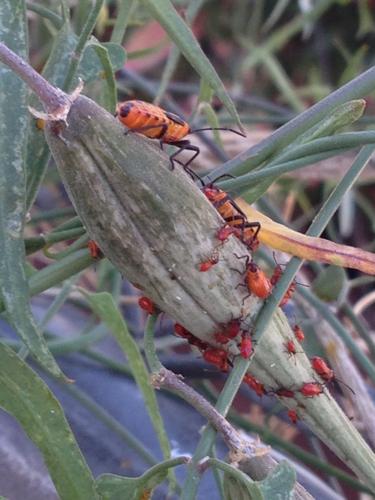
- By Peter L. Warren Special to the Arizona Daily Star
Q: What are these bugs on this milkweed?
A: The red and black ones are milkweed bugs. That might seem like a snarky answer but it’s the official common name for these insects otherwise known as Oncopeltus fasciatus. They can also be found on oleander plants, which might explain why the yellow insects are called oleander aphids (Aphis nerii).
Both species are commonly found on milkweed and oleander plants. Insects tend to favor specific plants or plant families when they feed. Milkweed and oleander are relatives from the same plant family and known for their sap that contains cardiac glycosides, which are poisonous. The insects that ingest it as a food source are able to sequester it and become protected to some extent.
If you watch other animals preying on these insects, you may notice they spit them back out. The red and yellow coloration is nature’s way of warning predators to leave them alone but not everyone understands the warning signs without a taste test.
Peter L. Warren is the urban horticulture agent for the Pima County Cooperative Extension and the University of Arizona. Questions may be emailed to
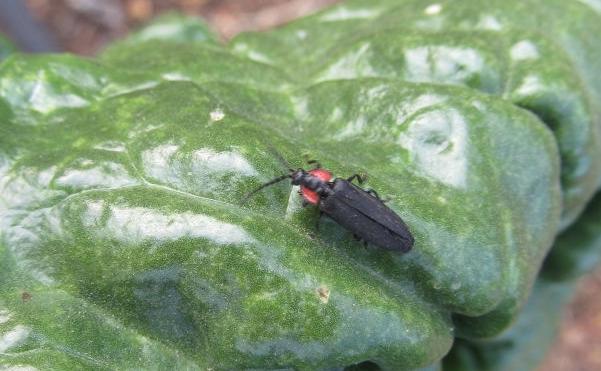
- By Peter L. Warren Special to the Arizona Daily Star
Q: When your time permits, Would you share your thoughts on this newest visitor to the garden? He/she has increased in numbers over the past weeks and I have yet to determine which plant is part of their meal choices.
A: The insect, Pyropyga nigricans, is a firefly species without a light. These are predatory insects and are garden helpers so you’re lucky to have them.
Peter L. Warren is the urban horticulture agent for the Pima County Cooperative Extension and the University of Arizona. Questions may be emailed to

- By Peter L. Warren Special to the Arizona Daily Star
Q: I have a lilac bush, which I purchased from a mail order company. It is about 12 years old, and it has never bloomed a single flower. It grows larger each year and has lush green foliage. I have given it fertilizer but nothing seems to help. What am I doing wrong?
A: The common lilac (Syringa vulgaris) is a favorite in many places so I understand your desire to grow them. Unfortunately, your place might not be suitable. Lack of blooms is usually related to one of six causes: the age of the plant, temperature, alternate flowering, light, nutrition, or pruning practices. In your situation, I think the likely problem is temperature. Lilacs require a certain amount of cold to trigger blooming, also known as vernalization. We don’t usually get enough cold in Southern Arizona for this plant to bloom unless you live at higher elevations. There are lilacs at the Santa Rita Experimental Range near Green Valley than have been monitored for bloom times by the USA National Phenology Network for many years. The elevation there is approximately 3,714 feet above sea level. You can check their web site for details if you are interested: usanpn.org/nn/lilacs
In downtown Tucson, where the elevation is closer to 2,389 and winter is barely recognizable, it’s too warm.
Peter L. Warren is the urban horticulture agent for the Pima County Cooperative Extension and the University of Arizona. Questions may be emailed to
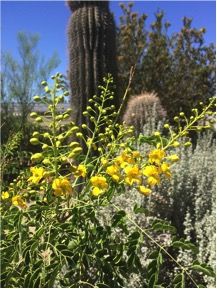
- By Peter L. Warren Special to the Arizona Daily Star
Q: My husband pruned two of our Mexican bird of paradise shrubs way down. Only one came back and is doing nicely. We have watered and used Miracle Grow fertilizer on the other one but nothing happens. Will it come back next season or do we need to replant a new one?
A: If you aren’t seeing any new growth by now, I suspect it’s a goner. You can scratch the surface of the branches to see if there is any green beneath. The good news is you can probably plant new ones from the seeds of the one that is doing nicely. The Mexican bird of paradise (Caesalpinia mexicana) is one of three species that grow in our area. The other two are the yellow (Caesalpinia gilliesii) and red (Caesalpinia pulcherrima) birds of paradise. A good time to prune is once blooming is finished. If you cut them too short, you risk killing them. Try just cutting back the top third next time to be safe. The flower stalks on all three species may be removed to prevent seedpods from forming and to reduce the likelihood of volunteer seedlings. If the pods are left on the plant to dry and split, the seeds can be thrown a surprising distance. The red bird of paradise dies back to ground at temperatures below freezing. It generally regrows in spring, from the ground and the dead parts can be pruned to a few inches above the ground in late winter. Mulching the base of plant in colder areas may protect the plant’s crown until spring.
Peter L. Warren is the urban horticulture agent for the Pima County Cooperative Extension and the University of Arizona. Questions may be emailed to

- By Peter L. Warren Special to the Arizona Daily Star
Q: I plan to buy a 15-gallon fruitless olive tree. Please tell me how much water daily or weekly it should be given once planted. The irrigation system in place for shrubs and trees comes on Monday and Friday for one hour. There are two black adjustable 10-gallon emitters where the tree will be planted. If the tree requires daily watering instead of the two days, I can water with a hose. When the temperature increases to 90 and higher, the irrigation system waters Monday, Wednesday, and Friday for two hours.
A: Olive trees should receive water every seven to 10 days in the summer to a depth of 24 to 36 inches. In the spring and fall, you can water every 10 to 14 days and in the winter, you can water every 14 to 21 days. Typically, two emitters can supply new trees as you described. As trees get older and their root zones increase in size, adding an emitter to the increasingly wider circle of drip irrigation would be appropriate every few years. The depth of irrigation can be measured with a soil probe. The schedule you are using now is watering too often and will encourage shallow root growth that will be more susceptible to our blast furnace summer heat.
Peter L. Warren is the urban horticulture agent for the Pima County Cooperative Extension and the University of Arizona. Questions may be emailed to
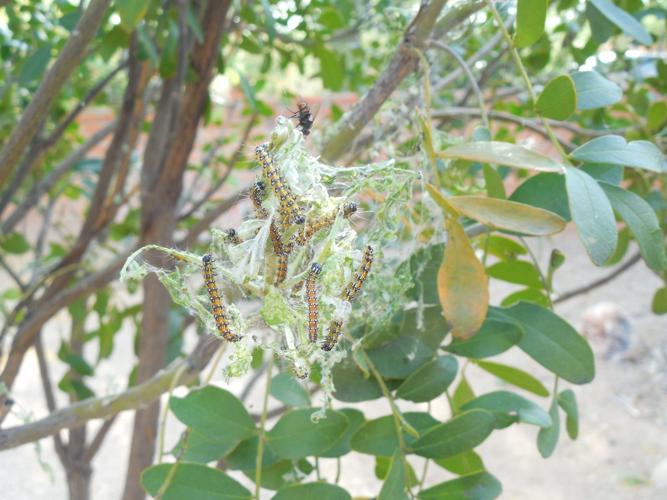
- By Peter L. Warren Special to the Arizona Daily Star
Q: These caterpillar bugs are all over my Texas mountain laurel (the same one that had the red and black plant bugs in March – which I sprayed off with a soap solution). There are probably at least 10 groups of these caterpillars on the tree. Suggestions?
A: These insects are called genista caterpillars (Uresiphita reversalis) and they are commonly found throughout the southwest on Texas mountain laurels. Their damage doesn’t affect the overall health of the tree unless there are unusually high numbers of them. The damage is often only cosmetic. The same soap solution can be used against these caterpillars. Soap acts an irritant and doesn’t always completely solve the problem. You might get the same result by spraying them with a hose. The benefit of the caterpillars is they are food for birds so you could leave them there and put up with the minor damage the caterpillars cause when feeding. Other solutions include pruning off the infested ends of branches, hand-picking the caterpillars, and various insecticides labeled for use on landscape trees and shrubs. An organic solution is spraying Bt (Bacillus thuringiensis) on the leaves where they are feeding. This works best when the caterpillars are young and most susceptible to the poison. The Bt bacteria are poisonous to caterpillars but not to anything else. Since there are several strains of Bt, make sure you use the one labeled for caterpillar pests. As always, when using any pesticide it is important to read the label and follow instructions to protect you and those other non-target organisms that might be exposed to the spray. By the way, the red and black bugs (Lopidea major) you saw earlier this year are also just a minor pest that feeds on Texas mountain laurel.
Peter L. Warren is the urban horticulture agent for the Pima County Cooperative Extension and the University of Arizona. Questions may be emailed totucsongardensage@gmail.com

- By Peter L. Warren Special to the Arizona Daily Star
Q: I have a question about compost. My neighbors have two eucalyptus trees, which shed many leaves into my yard. Are these good to put into the compost or not? I have concerns because of oil they may have in the leaves.
A: Eucalyptus leaves are fine for compost. They need to be broken down like any plant matter put into compost so that any compounds that are otherwise harmful will be neutralized. The oil that you refer to has been reported to interfere with germination in some plants but that is not something to be concerned about with composted material.
Peter L. Warren is the urban horticulture agent for the Pima County Cooperative Extension and the University of Arizona. Questions may be emailed to tucsongardensage@gmail.com
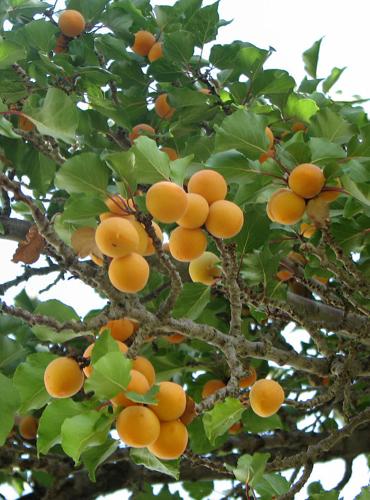
- By Peter L. Warren Special to the Arizona Daily Star
Q: This may be an odd question but here goes: I have an apricot tree in my yard (at least 15 years old) and it was a dwarf/ semi-dwarf when I planted it. I chose one that required the lowest chilling hours. I cannot remember the type or the name. It is still a reliable producer, self-pollinating and ripens in May. Do you have any guesses what the name of it could be? I think I remember the name included the word Gold.
A: I suspect your apricot variety is Gold Kist. This is an excellent backyard apricot for warm winter climates. Its features include very good quality, freestone fruit, and it is heavy bearing. It is an early harvest variety, from late May to early June. It requires 300 chill hours and is self-fruitful.
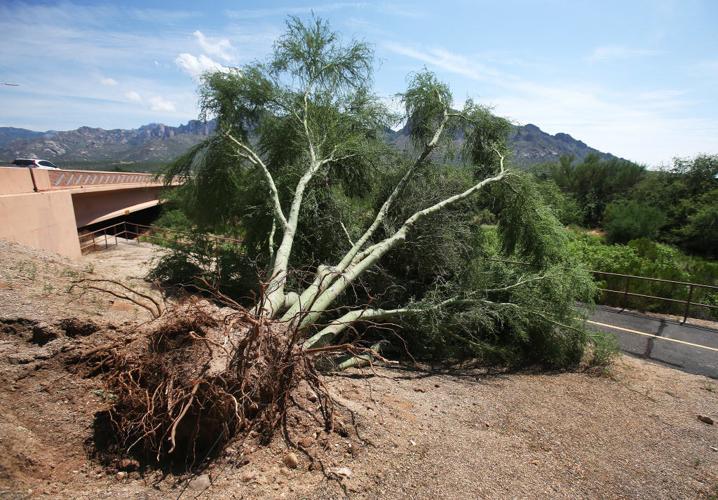
- By Peter L. Warren Special to the Arizona Daily Star
Q: I have a question related to the “Desert Museum” palo verde.
I want to plant this tree at our house, but I am a little wary because of the threat of palo verde beetles getting to the roots and killing it prematurely. Perhaps you can help me assess this risk?
A: The main risk for these beetles is an unhealthy tree. The palo verde beetle is endemic to this area and there is little to be done to a tree that has been infested. They are known to attack stressed trees so the best prevention is to keep trees as healthy as possible. This is primarily accomplished by providing proper irrigation and pruning. Since these are native desert trees they can survive on rainwater but when we have drier conditions than usual, supplemental water can help. Typically for desert trees this means installing drip irrigation around the tree at the drip line and providing deep watering to a depth of 24 to 36 inches every 14 to 21 days in the spring, summer, and fall. In the winter you can skip the irrigation, assuming we have normal winter rains. Proper pruning when the tree is young will result in a mature tree that is structurally stronger, lives longer, and is less costly to maintain. Don’t be in a hurry to prune at planting. A newly planted young tree should be given a chance to put down roots before taking any branches off unless they were damaged in the planting process. After a year or so it will be time to structurally prune your tree to ensure its long-term health.
Peter L. Warren is the urban horticulture agent for the Pima County Cooperative Extension and the University of Arizona. Questions may be emailed to tucsongardensage@gmail.com
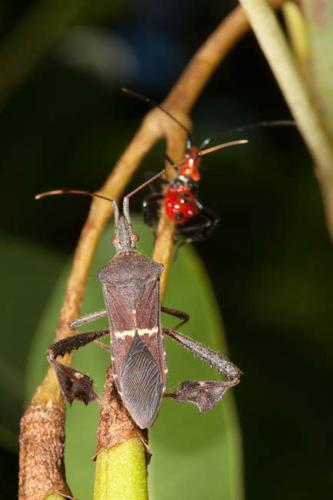
- By Peter L. Warren Special to the Arizona Daily Star
Q: This year, we have some peaches with dimples. The fruit is rotten inside. Could it be a plant pathogen of some kind?
A: The short answer is yes. Your peaches are likely suffering from a pathogen as a result of insect feeding damage. The prime suspect in this case is the leaf-footed bug. These insects have piercing-sucking mouthparts and while feeding on young developing fruit leave scars that are known as cat-facing and sometimes this feeding activity will introduce fungi that may cause the rot.
Leaf-footed bugs are common in our area and may feed on a variety of plants including pomegranate, pecan, citrus, and peaches. They are difficult to manage once in the adult stage because they can fly and move about quickly.
There are insecticides available, but they are only effective on the young bugs. These insecticides are harmful to bees, so take care to avoid spraying plants in bloom. Monitoring for and removing egg masses in the early spring is another tactic that is potentially more successful if you are persistently looking in the spring when eggs are laid and young bugs are emerging from them.
Peter L. Warren is the urban horticulture agent for the Pima County Cooperative Extension and the University of Arizona. Questions may be emailed to tucsongardensage@gmail.com
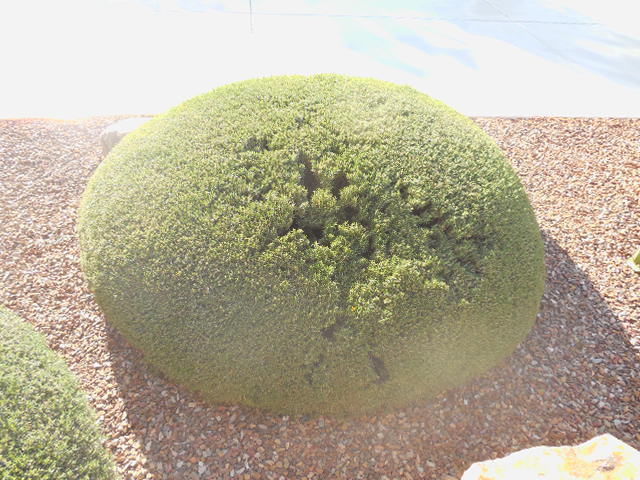
- By Peter L. Warren Special to the Arizona Daily Star
Q: What is going on with my rosemary bush? Two days ago I looked at the bush and discovered damage.
A: Rosemary (Rosmarinus officinalis) is a shrub that grows well in the desert. The natural form is shaggier than the sheared version you have growing. The damage you are seeing is likely a result of regular shearing of the foliage. Often shearing creates a shell of green that prevents light from entering the inner parts of the plant. Eventually dead spots will occur and regrowth from those branches will not likely happen. A better treatment would be less frequent light pruning as necessary and in a more selective fashion to allow the plant to achieve its natural form and to open up the plant a bit to light, air, and water.
Peter L. Warren is the urban horticulture agent for the Pima County Cooperative Extension and the University of Arizona. Questions may be emailed to tucsongardensage@gmail.com
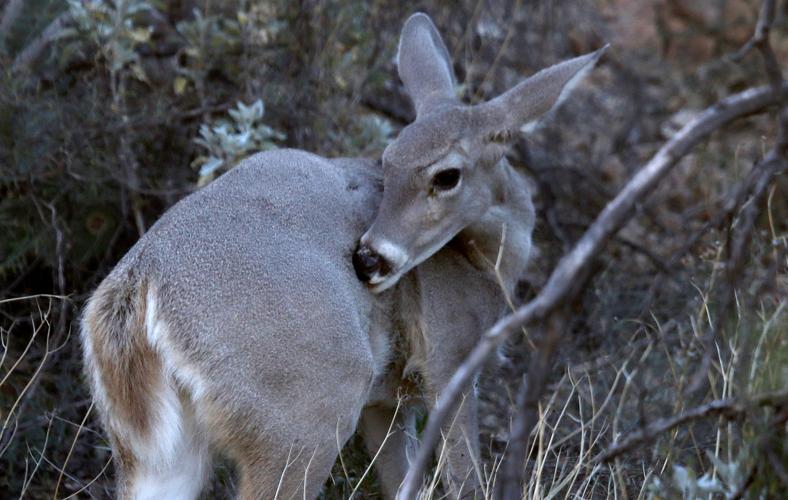
- By Peter L. Warren Special to the Arizona Daily Star
Q: We have 30-year-old Rhaphiolepis indica planted in a slightly raised planter. One side was particularly hit hard by the freeze a few years ago (17 degrees in Tucson in February), or so we thought, until we caught a couple of deer munching on that particular shrub. It never recovered from the munching. The shrubs on the other side of the planter were doing well until four deer became emboldened and began munching on the flowers and new leaf growth on the other side near our front gate. Those plants, too, have stopped putting on new leaves and weeks later look exactly like the deer left them. What can we do to rejuvenate the plants/encourage them to grow again?
A: Deer munching is definitely a hazard for Rhaphiolepis indica (Indian hawthorn), so some sort of fencing or detours around your shrub are required before you spend a lot of time on rejuvenation.
The best time to prune is around May or when it is finished blooming. You can selectively prune out the damaged branches where deer were feeding. From your photo the shrub looks pretty full and selective pruning should help open it up to more light, air, and water as well. Otherwise, continue to provide sufficient water, fertilize annually and monitor deer activity as needed.
Peter L. Warren is the urban horticulture agent for the Pima County Cooperative Extension and the University of Arizona. Questions may be emailed to tucsongardensage@gmail.com
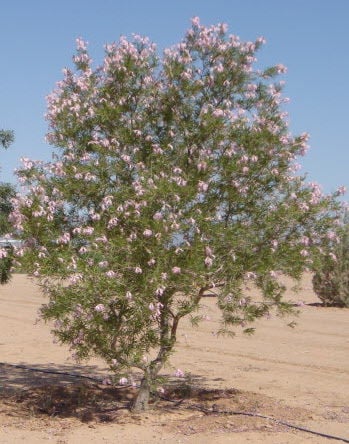
- By Peter L. Warren Special to the Arizona Daily Star
Q: I am sending two photos of my desert willow tree, now in its fourth spring. The buds form, grow and then dry out before opening. Have taken samples to Mesquite Valley Growers. They see no evidence of pests or disease, and recommended more water and fertilizer. The leaves seem smaller and shorter than others I see.
A: I agree with Mesquite Valley Growers; the symptoms you describe are likely related to insufficient watering. The recommended schedule for desert trees is once every two to three weeks in the spring, summer, and fall to a depth of 24 to 36 inches. An annual spring fertilizer application wouldn’t hurt either, making sure the fertilizer is watered in to reach the absorbing roots.
Peter L. Warren is the urban horticulture agent for the Pima County Cooperative Extension and the University of Arizona. Questions may be emailed to tucsongardensage@gmail.com
- By Peter L. Warren Special to the Arizona Daily Star
Q: I purchased this sugar bush at Desert Survivors Native Plant Nursery two years ago. It chronically looks like it isn’t getting enough water; there are dry, brown leaves. It is planted in desert soil with a cactus mix amendment. It is on a shrub line that runs twice a week right now, for 2½ hours. I have played with the emitter flow and am putting about 20 gallons each application. It gets sun until about 3 p.m. Is there anything I can do to help it thrive?
A: Sugar bush (Rhus ovata) is a moderate water user but twice per week at 20 gallons each application seems like a lot of water for a native shrub. If you aren’t checking to see how deep the water is going, I suggest using a soil probe to determine the depth of the watering. Ideally, water should reach a depth of 24 to 36 inches. I recommend backing off your irrigation to once a week for the summer and once every two weeks in the spring and fall.
Overwatering sometimes shows similar symptoms to underwatering, so looks can be deceiving.
Peter L. Warren is the urban horticulture agent for the Pima County Cooperative Extension and the University of Arizona. Questions may be emailed to tucsongardensage@gmail.com

- By Peter L. Warren Special to the Arizona Daily Star
Q: I have a customer who is trying to identify a plant. She says it can change directions of the branching/leaves almost at will. It has leaves like a wild chive or a hesperaloe combination.
A: It is from the genus Kniphofia, and commonly called tritoma, red-hot poker, torch lily, knofflers, or poker plant. They are closely related to aloes, although Kniphofias don’t have very succulent leaves. There are quite a few species and cultivars of different colors. It is native to Africa. The plant has a mature height of 2 to 4 feet and a width of 3 feet. It does well in a site with full sun and well-drained soil.
Peter L. Warren is the urban horticulture agent for the Pima County Cooperative Extension and the University of Arizona. Questions may be emailed to tucsongardensage@gmail.com
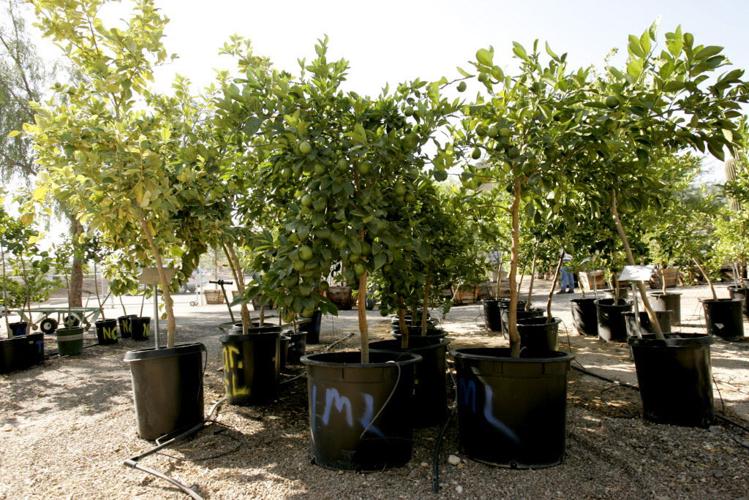
- By Peter L. Warren Special to the Arizona Daily Star
Q: My orange tree has been very productive for 14 years but it put out small fruit last year and this year it is blooming more than a month later than usual. Is something wrong with my tree?
A: Both symptoms you described, small fruit and odd bloom time, are associated with lack of water. It is possible that your irrigation system needs adjusting, so that would be the first thing to check. Also we had a relatively dry late winter and early spring this year. If you reduced your irrigation for the winter as recommended and then experienced no rain in February and March, your tree was probably in need of more water. Citrus trees sometimes respond to drought conditions followed by rain with a bloom about a month later, which corresponds to the rain you had in early April.
Peter L. Warren is the urban horticulture agent for the Pima County Cooperative Extension and the University of Arizona. Questions may be emailed to tucsongardensage@gmail.com

- By Peter L. Warren Special to the Arizona Daily Star
Q: How likely are seriously neglected mature citrus trees to recover?
Our trees are located in central Tucson and have curling leaves, and we will not be able to water them until after May 20. They probably have not been watered (other than rain of course) since last summer.
A: It’s hard to say for sure without seeing them. Curling leaves is a symptom of drought so watering soon would be good. That said, at least the leaves are still on the tree and that should give you hope. The next thing the trees will do without water is drop the leaves to reduce the amount of water escaping into the atmosphere through the leaves. Make sure that when you have the opportunity to water that you put the trees on drip irrigation arranged in a circular fashion around the drip line of the trees. The timing should be set for once every seven to 10 days now that we are experiencing the hottest and driest part of the year. Also make sure the water gets to a depth of 36 inches in the soil. You can measure this with a simple soil probe.
Peter L. Warren is the urban horticulture agent for the Pima County Cooperative Extension and the University of Arizona. Questions may be emailed to tucsongardensage@gmail.com
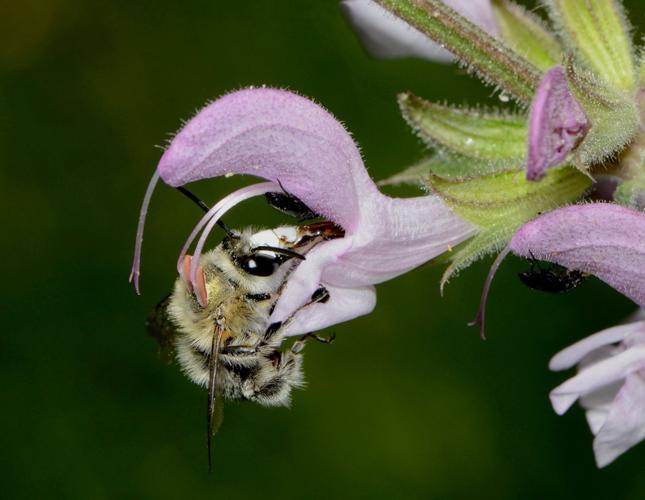
- By Peter L. Warren Special to the Arizona Daily Star
Q: Why are bees in my vegetable garden? They appear to be digging in the soil. Makes it impossible to get veggies.
A: Many species of solitary bees make their homes in the soil. A group called digger bees or Anthophora (meaning “flower bearer”) are extremely common and they sometimes nest in large numbers like a community of single-family homes. Your garden is likely a good spot, according to the bees. They are not typically aggressive should you want to work around them. If you want to discourage them from nesting there, one thing you can try is using an overhead sprinkler in the area where they are nesting. Digger bees will often seek a new habitat if there is regular water raining down on their holes. Since these are also some of our native pollinators, it is good to keep them alive and nearby, if not in your garden.
Peter L. Warren is the urban horticulture agent for the Pima County Cooperative Extension and the University of Arizona. Questions may be emailed to tucsongardensage@gmail.com
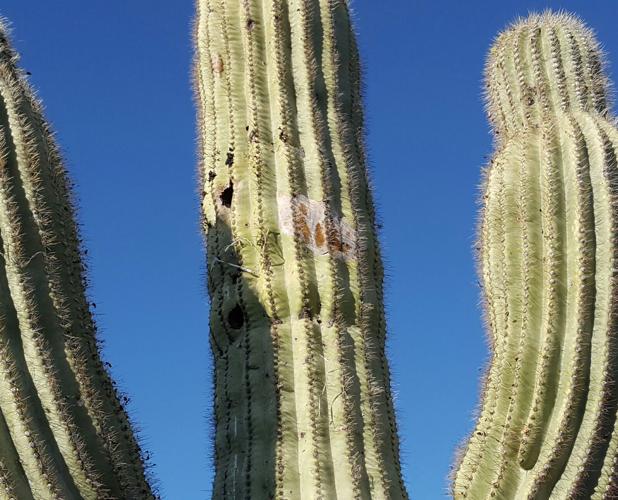
- By Peter L. Warren Special to the Arizona Daily Star
Q: We live at 4,000 feet of elevation at the base of the Santa Ritas and have two “rescued” saguaros and one nursery bought.
The biggest is George (pictured). We moved George here in 2010 from a construction excavation site. We have licenses for all three of them. He did great first year then 2011, the winter from hell, arrived. A great deal of his south side froze in the wet, windy, and below-freezing temps we had for four days. He survived the damage and thrived. The side in this picture is facing north toward the Catalinas. Over the past few years, he has become a high rise apartment complex for Gila woodpeckers. This year three additional holes appeared as prior holes are now occupied by European starlings. Now he has six large holes. A month ago this splotchy patch (pictured) appeared on the north side, underneath a rather large hole taken over by the starling family. Is this some kind of fungus or could the tissue be damaged from internal carving of the hole inside and nearby? Never had the starlings before and given George’s height, no way to get rid of them. At least the Gilas return to the same homes every year but this year had to drill more!
A: The splotchy patch appears to be a symptom of bacterial necrosis caused by the bacterium Erwinia cacticida. The initial symptom is typically a small, light-colored spot with a water-soaked margin on the surface of the trunk or branches. Obviously, you are looking out for George because symptoms like that could easily go unnoticed. The tissue under the infection site appears to be showing a brown color and may eventually turn almost black. As the disease progresses, the tissue may crack and exude a dark brown liquid. If decay is slow, the tissue may not show the liquid. Although it’s tempting to blame the invasive European starlings, the bacteria could be transmitted by any number of animals, not to mention wind blowing it in from nearby plants.
If the damage was very small and reachable, I might suggest carving it out. Given the height of George and the spread of the symptoms, it might be best to either call an arborist with the proper equipment to reach that high or just let nature take its course. I can’t tell if there is any danger to people or property from the photo but it would be wise to consider the potential hazard if the problem gets a lot worse.
Peter L. Warren is the urban horticulture agent for the Pima County Cooperative Extension and the University of Arizona. Questions may be emailed to tucsongardensage@gmail.com
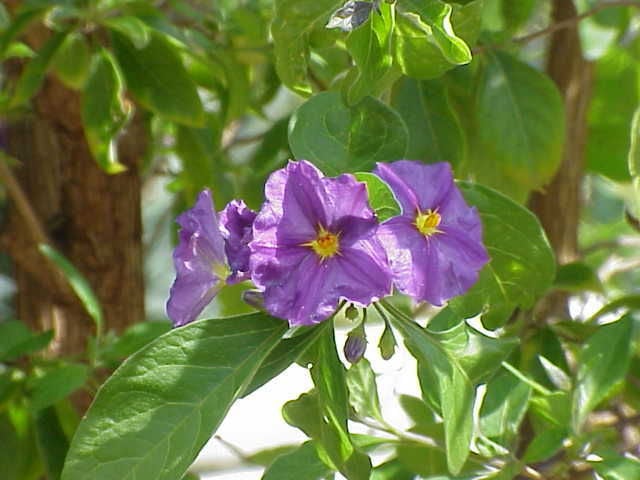
- By Peter L. Warren Special to the Arizona Daily Star
Q: I have a royal robe potato bush that when planted last year grew beautifully! I live in Hayden so the plant is in the full sun all day.
This year, however, it is not doing well at all. I believe the reason is that it was hit hard during the winter freeze. I trimmed the branches back to about 10 inches from the roots. Even though the branches are very dry and snap off easily there are actually some green leaves growing on a few of the branches. Should I just dig it up and start over, or wait awhile to see if it comes back to the original beauty I had from the beginning?
A: The royal robe potato bush (Lycianthes rantonnetii or Solanum rantonnetii) is a tropical plant that originated in South America. It grows well in our heat with adequate water but needs a little protection in the winter if temperatures get below freezing. Because potato bushes flower on new wood, prune them in winter before they start to put out new growth. You can prune them as early as they have finished blooming for the year. The golden rule of pruning is never take off more than a third at one time to avoid stressing out the plant. Since yours has new growth showing, you could see how it grows before giving up and starting over.
Peter L. Warren is the urban horticulture agent for the Pima County Cooperative Extension and the University of Arizona. Questions may be emailed to tucsongardensage@gmail.com
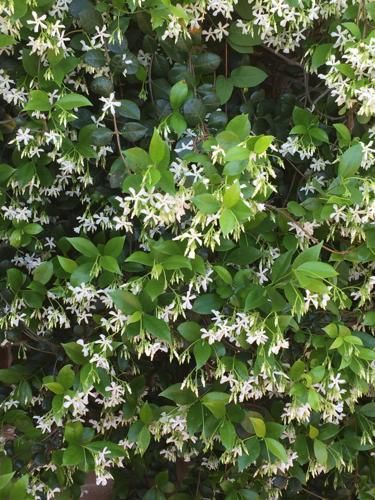
- By Peter L. Warren Special to the Arizona Daily Star
Q: We just installed five viga posts on our back patio. Two of them are where I could plant a vine in the ground; the other three need to be in a pot. Height to the patio roof is about 11 feet. Looking for something I can train to grow up and around the post, but the kind that cling. The area gets morning sun until about 11:30 a.m. and then shade the rest of the day. Flowering, thornless and non-deciduous would be ideal. Would also like to find a vine that I might be able to use along our retaining wall, specifically in the sections that have an iron railing between the stucco posts. This would be full sun most of the day and the height of the iron fence is about 6 feet.
Answer: My first thought is star jasmine because I have it growing at my house and it’s flowering now. It does well in part shade and produces very fragrant flowers in the spring. For the retaining wall, you might consider cat’s claw. This vine loves full sun and will cover a sturdy wall. These are fast growing and need to be managed but most vines are that way to some extent. There are other vines to choose from; search for options at az1606.pdf
Peter L. Warren is the urban horticulture agent for the Pima County Cooperative Extension and the University of Arizona. Questions may be emailed to
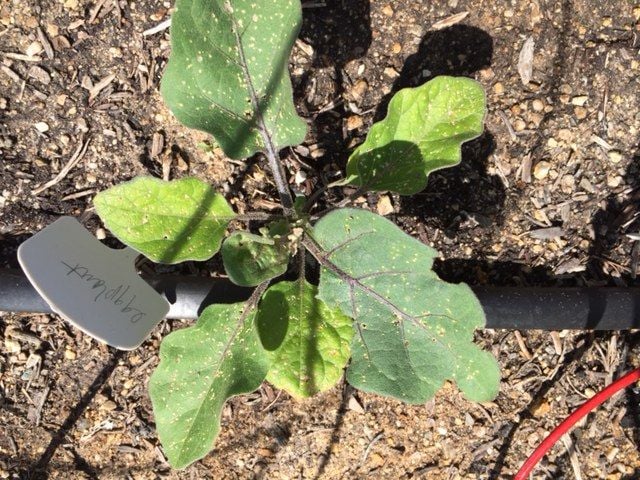
- By Peter L. Warren Special to the Arizona Daily Star
Q: Thanks for the bug lesson last weekend at the Jewish Community Center. Thanks to you, I was able to identify lace bugs on our sunflowers (you predicted they would show up) and I mitigated with blue Dawn. While there, I noticed that our Japanese eggplant have something going on with them. Are you able to help out based on the two images I am including? No insects were visible.
A: Flea beetles are eating your eggplant leaves. They are tiny and hard to see, and they tend to jump like fleas when they sense danger. They are one of the most difficult-to-manage pests of eggplant and cole crops. They are also a problem on seedlings of tomatoes, potatoes, peppers, turnips, radishes and corn. There are various species of flea beetles, all members of the Chrysomelidae family. The adults are active leaf-feeders that can, in large numbers, rapidly defoliate and kill plants. You are seeing the symptoms of adult flea beetle feeding: small, rounded, irregular holes that make leaves look as if they had been peppered with fine shot. Additional damage may be done by the larvae, which feed on plant roots. Some flea beetles are considered general feeders, though many species attack only one plant or closely related kinds of plants. Because of this you can sometimes use anther crop to lure them away. For example, radishes are sometimes preferred over eggplant. Another tactic is to put yellow sticky traps near your plants to attract and capture these insects. Organic products that have some effectiveness are insecticidal soap and neem oil. Pyrethrin products such as Pyganic as well as hot pepper wax and rotenone are reported to be better.
No matter what you choose, the most important things to do are spray them early in the season before they do too much damage to young plants and read the label before you use these products so you are aware of safety precautions for using them.
Peter L. Warren is the urban horticulture agent for the Pima County Cooperative Extension and the University of Arizona. Questions may be emailed to
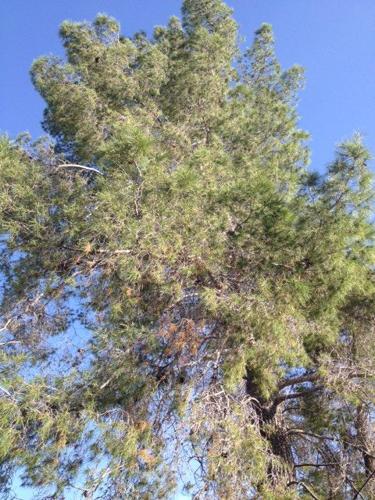
- By Peter L. Warren Special to the Arizona Daily Star
Q: I live in Barrio Santa Rosa and have two massive Aleppos that were planted on my property in the early 1950s. I have noticed recently that many of the lower branches on one of the trees are dying. I am seeing brown needles throughout the tree, but not a lot. These trees have defined our property and it looks like they may have fallen victim to the bark beetle. One of the trees looks fine; the other I can see a dozen of the lowest limbs dead. This one has brown leaves sporadically throughout, but mostly at the bottom, not at the crown.
I have had the entire property on drip for 15 years or more, so I always considered them adequately watered. Also, the gutters from the roof drain into this part of the yard. Any advice you can give me would be greatly appreciated. What I’d really like to hear you say is that they just need a bit more water!
A: Your trees don’t appear to be infested with bark beetles from the photos. The holes look like woodpecker damage and the dead branches in the crown of the tree are normal as the trees age. It would be good to hire an arborist to climb the trees and cut out the dead and damaged branches both to clean it up and also to prevent dead limbs from falling and hurting you or damaging your property. Watering these large trees is difficult because the root zones extend two to three times the height of the tree. You are likely not getting water to the absorbing roots at the end by using a hose. The best you can do is drip irrigation with emitters arranged in a circular fashion outside the drip line of the tree. The schedule for watering should be every seven to 14 days in the summer, every 10 to 21 days in the spring and summer, and every 14 to 21 days in the winter. The water should reach a depth of 24 to 36 inches each time and you can use a soil probe to determine how deep the water is going. So it’s not time to give up
Peter L. Warren is the urban horticulture agent for the Pima County Cooperative Extension and the University of Arizona. Questions may be emailed to
Tags
View this profile on Instagram#ThisIsTucson 🌵 (@this_is_tucson) • Instagram photos and videos
Most viewed stories
-
Over 40 free events happening in Tucson this December! ⛄
-
Save the date! Here's the ultimate list of Tucson holiday events 🎄
-
A large list of fun and festive events in December! 🎄❄️
-
20 gifts under $20 from Tucson shops! 🎄🎁
-
Cafe Maggie suddenly closes doors on Tucson's North Fourth Avenue
-
More than 40 fun events in Tucson, December 12-14! ❄️✨
-
A giant guide to gifts made by Tucson makers and small businesses
-
17 festive holiday markets that support Tucson artisans
-
Satisfy your pozole craving at these 9 local places!
-
Get fresh bread and flaky, buttery croissants at the MSA Annex's new micro-bakery 🥖



